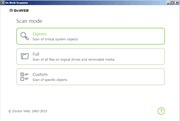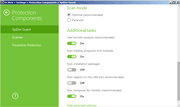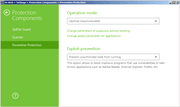Efficient detection and neutralization of all types of threats (Dr.Web Scanner)

- What's new in Version 11! Virus scanning is faster than ever thanks to the enhanced Dr.Web Scanning Engine.
- High-speed scanning with several scanning threads powered by multi-core systems
- Thorough scanning of RAM, boot sectors, hard drives and removable data-storage devices, for viruses, Trojans and other malware.
- Detection of active virus threats only.
- Comprehensive databases for detecting spyware, riskware, adware, hack tools, and jokers.
- The Dr.Web Shield™ anti-rootkit used by the Scanner detects complex viruses that use rootkit technologies and are able to conceal themselves in an infected system.
- The console scanner intended for experienced users enables the anti-virus to be run from the command line. It offers users a wide range of options and also utilizes multi-core features.
Real-time protection (SpIDer Guard® file monitor)

- SpIDer Guard monitors system health in real time and intercepts "on the fly" all calls to files located on local drives, floppy discs, CD/DVD/ Blue-ray disks, flash drives, or smart cards.
- The file monitor is highly resistant to attempts by malicious programs to disrupt or halt its operation.
- State-of-the-art technologies implemented in the Dr.Web anti-virus engine enable it to monitor the availability of system resources and control its “appetite”, while maintaining effective protection.
- High performance on machines involved in intensive data stream processing (involving heavy use of file systems, downloading files via torrents, compiling and video rendering).
Protection against unknown threats (preventive protection)
The technologies incorporated into Dr.Web Preventive Protection enhance traditional signature-based detection with cutting-edge behavioural analysis. With preventive protection Dr.Web can:
- Protect systems against new, highly prolific malicious programs that are capable of avoiding detection by traditional signature-based analysis and heuristic routines because they haven't yet been analysed in the anti-virus laboratory and, therefore, are unknown to Dr.Web at the moment of intrusion;
- Detect unwanted file modification, monitor the operation of all system processes to detect actions that are typical of malware (e.g., encryption ransomware activities), and prevent malicious objects from injecting their code into other processes;
- Detect and neutralise threats that have not yet been discovered and entered in the Dr.Web virus database: encryption ransomware, injectors, remotely controlled malware used for espionage and to create botnets, and malware packers.
And those are just a few of the things that Dr.Web Preventative Protection can do. Find out here

High level of self-protection
Dr.Web is immune to any attempts by malicious programs to disrupt its operation. Dr.Web SelfPROtect is a unique anti-virus component that maintains anti-virus security.
- Dr.Web SelfPROtect is implemented as a driver that operates at the lowest system level. It cannot be stopped or unloaded until a system is rebooted.
- Dr.Web SelfPROtect restricts access to networks, files and folders, certain branches of the Windows Registry, and removable data-storage devices at the system driver level, and protects software from anti-viruses aiming to disrupt Dr.Web’s operation.
- Some anti-viruses modify the Windows kernel by intercepting interruptions, changing vector tables, using other undocumented features, etc. This may have a negative impact on the stability of a system and pave new ways for malicious programs to get into a system. At the same time, Dr.Web SelfPROtect maintains the security of the anti-virus and does not interfere with Windows kernel routines.
- Automatic restoration of its own modules.
New in version 11! The new Dr.Web Hypervisor component uses state-of-the art CPU capabilities to upgrade threat detection and neutralisation routines and to strengthen Dr.Web’s self-protection capabilities. The component runs beneath the operating system to maintain control over all programs, processes, and the operation of the OS. It makes sure no malware can gain control over a system protected by Dr.Web.
Dr.Web developers adopted this approach to overcome the limitations that exist for anti-viruses running on 64-bit platforms when an anti-virus has to operate on the layer used by malware.
The component is compatible with VirtualBox, VmWare, Hyper-V, Parallels.







![[You Tube]](https://st.drweb.com/static/new-www/social/youtube.png)
![[Twitter]](https://st.drweb.com/static/new-www/social/twitter.png)
![[Facebook]](https://st.drweb.com/static/new-www/social/facebook.png)
![[Instagram]](https://st.drweb.com/static/new-www/social/instagram.png)
![[Spiceworks]](https://st.drweb.com/static/new-www/social/spiceworks.png)